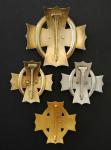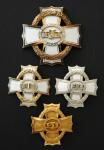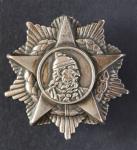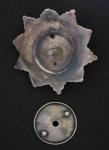-
Posts
1,161 -
Joined
-
Last visited
-
Days Won
17
Content Type
Profiles
Forums
Blogs
Gallery
Events
Store
Everything posted by Elmar Lang
-

Austria-Hungary Austro-Hungarian Pilots badge-a good copy
Elmar Lang replied to Gordon Craig's topic in Austro-Hungarian Empire
Hello, I can confirm that the Feldpilotenabzeichen is a recent copy (what's the "maker's mark" struck on the Albatros' reverse?), possibly made by Horvath in Budapest. The case also is not an austrian piece. Best wishes, Enzo -

Austria-Hungary Assailed From All Directions
Elmar Lang replied to a topic in Austro-Hungarian Empire
Hello, in the beautiful photographic portrait posted by Rick, count Degenfeld seems wearing (after what I can see in the rather faded detail of the picture) the most rare Leopold Order Star of Grand Cross with War Decoration of Lower Class (i.e. with golden laurel wreath between the enamelled centre cross' arms). Very, very interesting! Best wishes, Enzo -

Austria-Hungary Generalmajor Eduard Freiherr von Albori
Elmar Lang replied to a topic in Austro-Hungarian Empire
If I'm not wrong, General von Albori also received the MVK with brilliants... Best wishes, Enzo -
Hello, an excellent MVK (Friede) with a long dedication, raising from emerald-green enamel. Congratulations! Enzo
-
Hello, I regret to say that the MVK II Class with KD and Swords (these, being in silver, are those of III Class) is not an officially awarded piece. Originals are differently made and on the lower arm's rim there should be the mark "MARSCHALL". The general workmanship of the piece is in my opinion of a lower quality than wartime, awarded ones. I haven't been able to read the marks, but they could probably be from Austria's 1st or 2nd republic and be for imported silverware. Best wishes, Enzo
-

Austria-Hungary Neck-decoration of a Kaiserj?ger
Elmar Lang replied to Christian Zulus's topic in Austro-Hungarian Empire
Something very unofficial, for sure. E.L. -

EK 1914 1813 ek2 with envelope
Elmar Lang replied to Eric Stahlhut's topic in Germany: All Eras: The Iron Cross
Hello, O would like to try to see the problem in a philological way. The inscription on the paper has a wrong construction: it should be: Rosenthal, Juweliere Friedrich Strasse N?82 Berlin Or with "Berlin" above the address. Why should the label of a firm start with the city? I'm very suspicious with that paper. The cross looks late 19th Century, or even later, but a proper answer could be given having the cross in the hands: quite often, a picture isn't enough to judge a piece. Best wishes, Elmar Lang -

Austria-Hungary unneed help id ing turkish pin
Elmar Lang replied to logicalming's topic in Austro-Hungarian Empire
I think it's a French badge or a French-style badge of an arab country. Most possibly, post-1945. Best wishes, Elmar Lang -

Austria-Hungary unneed help id ing turkish pin
Elmar Lang replied to logicalming's topic in Austro-Hungarian Empire
? -

Austria-Hungary Kriegskreuz f?r Zivilverdienst
Elmar Lang replied to pinpon590's topic in Austro-Hungarian Empire
I agree, it's a decoration of very fine design, truly "Jugendstil". In any case, it's very difficult to find an ugly-designed imperial Austrian order or decoration... Enzo -

Austria-Hungary Kriegskreuz f?r Zivilverdienst
Elmar Lang replied to pinpon590's topic in Austro-Hungarian Empire
Hello, thank you for the comment: the 1st Class measures 63 x 63 mm. Best wishes, Enzo -

Austria-Hungary Kriegskreuz f?r Zivilverdienst
Elmar Lang replied to pinpon590's topic in Austro-Hungarian Empire
-

Austria-Hungary Kriegskreuz f?r Zivilverdienst
Elmar Lang replied to pinpon590's topic in Austro-Hungarian Empire
Hello, back to the theme of the Kriegskreuz f?r Zivilverdienste, I would like to add two pictures of the complete series, from the 1st to the 4th Class, from my collection; obverse and reverse. I hope that the marks struck on the reverse could be readable enough. Best wishes, Enzo Obverse: -

Austria-Hungary Photos of Austrian Reiterabzeichen in wear
Elmar Lang replied to Naxos's topic in Austro-Hungarian Empire
Hello, my opinion comes from the fact that the needle looks closely to those used by Souval of Vienna for his post-1945 products. Let's not forget that Souval, besides his sinister fame in the field of III Reich copies, was the supplier (before 1918) of the Milit?rverdienstkreuz of 1st and 2nd Class: its workmanship was of the highest level. Best wishes, Enzo -

Austria-Hungary Photos of Austrian Reiterabzeichen in wear
Elmar Lang replied to Naxos's topic in Austro-Hungarian Empire
Hello, in my opinion, observing the type of pin on the reverse, I think that the badge should be post-1945, possibly to substitute the awards of the German Reiterabzeichen from III Reich distributed after tha Anschlu? of 1938. Best wishes, Enzo -

Austria-Hungary Kriegskreuz f?r Zivilverdienst
Elmar Lang replied to pinpon590's topic in Austro-Hungarian Empire
Hello, from what we can see after the interesting communication of Josef, the Kriegskreuz f?r Zivilverdienste is a relatively rare decoration in all its classes; rare/scarce in the 1st Class, of course. The average price of the 2nd to 4th class is usually very moderate. It is interesting to note that this decoration was produced also by the "Wiener Werkst?tte f?r Angewandte Kunst" a famous atelier where perhaps the best Vienna "Jugendstil" pieces have been produced. Such pieces are struck with the superimposed double "W" mark. Best wishes, Enzo -

Austria-Hungary cased Karl-Truppen-kreuz
Elmar Lang replied to Iver's topic in Austro-Hungarian Empire
Poor soldiers!... Why should they receive their decorations and medals without ribbon? Of course, the Kaiser's pocket money was enough to pay the costs of ribbons also for Other Ranks... Best wishes, Enzo -

Austria-Hungary cased Karl-Truppen-kreuz
Elmar Lang replied to Iver's topic in Austro-Hungarian Empire
Try looking at the cross' rim; possibly, there's the maker's mark, like HMA, BSW, etc. A very rare case; it won't very difficult to complete the set with its proper ribbon bar. Enzo -

Austria-Hungary miniature of red cross decoration
Elmar Lang replied to Iver's topic in Austro-Hungarian Empire
An extremely fine and uncommon piece, especially for its full-size-like pinback mount. I congratulate! Enzo -

Austria-Hungary Austrian 10er ribbon bar
Elmar Lang replied to Claudius's topic in Austro-Hungarian Empire
Yes, Austrian-style swords, but on a post-1938 (or post-Anschlu?) German-style ribbon bar, belonged to an officer serving in the Austrian 1st Republic, then in the Wehrmacht. Enzo -
Hello, I would like to add two pictures of the numbered Skanderbeg III Class, recently added to my collection. It is made of silver; its measurements are: heigth: mm 48,0 width: mm 47,8 Award no. 3444. Best wishes, Enzo
-

Albania Award Document numbering/dating
Elmar Lang replied to Bob's topic in Southern European & Balkan States
Hello, Excellent contribution from Artan! I've recently added to my Albanian collection a Skanderbeg III Class, with number "3444". Is there any chance to know something more about its recipent and date of award? Best wishes, Enzo (Elmar Lang) -
Hello, I think I need to do a deeper research but, in my opinion, ribbon bars have been introduced in Austria during WW1. In earlier times, full-size decorations were usually worn also in field conditions. Best wishes, Elmar Lang
-
Hello, I'm doing a research about a Blutorden awarded to an SS Officer. The name is Reinhold Baumgartner, born on Dec. 16th, 1897 (in Saalfeld/Saale, Th?ringen), NSDAP membership number 289.772 and SS nr. 1.522.911. He received the SS Ring and was awarded with the Blutorden on Oct. 21st, 1939. Would it be possible to know the award number of his Blutorden? Many thanks in advance and best wishes, Enzo
-

Austria-Hungary Medal 2. December 1873 - Question?
Elmar Lang replied to wschmidt's topic in Austro-Hungarian Empire
Hello, an interesting question. Actually, the right to wear Kriegsmedaille should have been extended to the war started in 1914 (Imperial Decision from Dec. 16th 1916, where the medal is called "Kriegserinnerungsmedaille"), with a different ribbon (yellow with a black stripe on one side, the other with a green-white-red stripe). The Austrian Republican government, had the right to complete the award procedures, when started earlier that the armistice and abdication of the Emperor. This could be the case of the posted "Legitimation". Best wishes, Enzo





